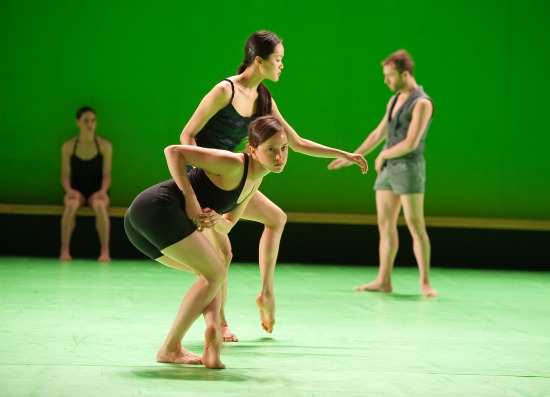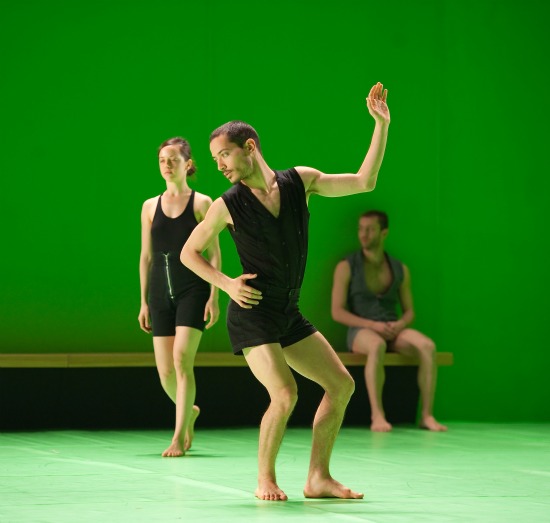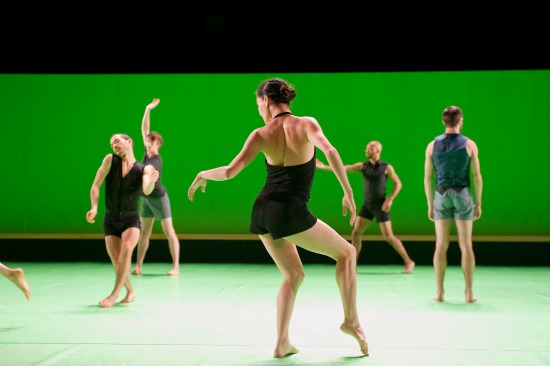
Ia'ara Moses and Chen-Wei Lee (at back Rachel Osborne, Matan David) in Ohad Naharin's Hora. Photo: Stephanie Berger
When Ohad Naharin left New York for Israel, his homeland, in 1990 and took over Batsheva Dance Company, he developed a distinctive movement style. In all his dances, the performers are muscular in unconventional ways. Watching them, I imagine elements of the inner apparatus that moves the human body trying to find new conduits into motion. Sometimes a dancer’s hip or a shoulder is impelled to trace a path on the air; sometimes the residue of an experience flutters out his fingers. Gaga, the training technique that Naharin devised, treats the body as an infinitely, subtly, changeable world to explore, as if the dancers who perform his choreography and the professionals and non-dancers who take his workshops were re-entering their infant bodies with an adult’s perspective and exploring motion on a cellular level. Company members are audacious, yet innocent with those rolling hips and shoulders, those craning necks. Unlike some contemporary choreographers, awkwardness is a quality Naharin neither dwells on nor exploits.
The Batsheva dancers who perform Naharin’s Hora at BAM (11 out of a company of 18) are connected to the earth even when striding on tiptoe or jumping like competitors in a sack race. When images of them pop into my mind, they’re most often taking wide strides and sinking into bent-kneed stances. Little that they do resembles conventional virtuosity or familiar styles, yet the unusual shapes that their bodies pass through or settle into, plus their decisive strength and delicate variations of that, as well as their sensuality, can induce a kinesthetic response in spectators.
Naharin has made works that uses text, like George and Zalman (2006), and pieces, such as Telophaza (2005) and Anaphaza(1993) in which the dancers involve the audience. He may include video projections, a puppet, chairs, or none of these. One dance may have a political edge, another a more playful one, but his choreography tends to express a tension between control and prescribed rituals on one hand and individual expression and freedom on the other. His dancers always appear to be members of a society, however formalized its codes of behavior and how outrageous and creative their rebellions (or temporary vacations) from it can be.

Ia'ara Moses, Shahar Biniamini, and (at back) Matan David in Ohad Naharin's Hora. Photo: Stephanie Berger
Hora is sparer than some of Naharin’s works. It’s also cooler in overall tone; rarely do the dancers appear vulnerable or require help. Only with a dash of irony can the title be related to the Israeli folk dance that kids learn in summer camp. These people aren’t into holding hands in a circle; yet they are members of a society with shared values. (The title may waft another allusion our way: “hora” means “hour” in Spanish, and that’s about how long the piece lasts.)
The performers inhabit a verdant (hence fertile?) world, devised by Avi Yona Bueno (Bambi). The stage is surrounded on three sides by grass-green walls that look to be about eight feet high. The floor, too, is green-tinged. No doors or windows. No one leaves the stage. When not active, the dancers sit on the bench at the back that spans the width of the area. They’re wearing various trim, mostly black outfits that leave their legs bare (costumes by Anna Mirkin). Sometimes it’s even prescribed how they sit. At one point, every person has her/his left leg crossed over the right. Within this contained space, the little society states its common values and its allowable digressions.
The fourth wall, however, is porous. As Hora begins, the dancers rise from the bench and walk at a measured pace, toes first, toward the front of the stage, staring at us. To a low humming that erupts into clamorous sounds, they turn sideways and stretch out their arms, hands dangling like paws; their heads, however continue to face the audience. From time to time, throughout the dance, we’re aware of these speculative, unemotional gazes, but for the most part, the performers focus on their own movements, discovering how gestures impel other ones. I have the impression that they see one another less frequently than they view the space around them.
For several minutes, when the group returns to the bench, and Shahar Biniamini begins to dance alone, I think of docile zoo animals. This may be partly because of Biniamini’s personal quality. With his long back and flexible hip joints, he seems creaturely. When he walks in a crouch or squats, I think of the monkey god in Asian dance-dramas, although he also takes off in a jolting, stiff-legged gait that’s much later echoed by another performer. Oiled joints like Biniamini’s are vital to Naharin’s style. When Adi Zlatin gazes toward us and raises one leg to the side in something between a turned-out side extension and a ballet arabesque, that leg seems to float to its destination, as if released from bondage.
When other performers gradually rise, one by one, and begin to move—Shamel Pitts, Ia’ara Moses, Bobbi Smith, Matan David—then in quicker succession—Iyar Alezra, Chen-Wei Lee, Ian Robinson, Doug Letheren, Rachel Osborne—something strange bubbles up in the score. Soundtrack designer Maxim Waratt (a pseudonym of Naharin’s) has not only made use of Ryoji Ikeda’s data.matrix, he has (with the assistance of Nir Klajman’s sound mastering) mixed in and melded Isao Tomita’s wacky, electronically manipulated arrangements and renditions of ten well-known musical classics. Suddenly we’re hearing what can gradually be recognized as Debussy’s Afternoon of a Faun; it sounds as if it’s being played in a fish tank. As the dance progresses, such masterworks as the “Ride of the Valkyries” from Wagner’s Die Walküre, Charles Ives’s The Unanswered Question, and the section of Richard Strauss’s Also Spracht Zarathustra used by Stanley Kubrick in the opening of 2001: A Space Odyssey ooze and rumble and whine.

Rachel Osborne (foreground) and (L to R) Shahar Biniamini, Ian Robinson, Shamel Pitts, Matan David. Photo: Stephanie Berger
The corrupted music is disquieting; it was, perhaps, Naharin’s intention both to distance us from the originals and to evoke in shadowy form the images we associate with them. The dancers’ movements, too, seem strange but also somehow familiar. We may feel at home watching three people roll together and lie spoon-fashion while a woman (I think it was Smith) dances alone. Nor is it the first time we’ve seen two women face each other, begin to lean forward, and stop the trajectory by butting shoulders (although Lee and Zlatin start this move daringly far apart). We may not know exactly what to make of two men facing each other and energetically scrubbing the fronts of their torsos, but the sudden surprise of it can stir a variety of remembered images.
As the dance swells and eddies, there are moments of unison (at one point the five women sit on their tailbones on the floor, legs and arms lifted, swaying slightly; then they crumple). Five couples perform identical maneuvers at the same time. Together, performers take off running, or cluster, or fall to the floor, or take tiny side-steps on tiptoe. Yet often two or more people dance alone simultaneously, as Osborne and Elezra do in a fairly long duet. In general, the performers seldom touch. It’s almost a shock when Moses pushes Letheren down onto all fours and calmly sits on him.
Hora is fascinating, although not emotionally involving. It’s like watching with intense curiosity the handsome human equivalent of an ant farm. What are these inhabitants’ jobs? Their inter-relationships? What results from what they’re doing? Perhaps Naharin’s point is that in this enclosed society, the whole-hearted doing is the point—both cause and result.

you are usually so correct in all your writing that i was rather surprised that you thought
“Ride of the Valkyries” from Wagner’s Tannahäuser – alas it is from die Walkure – it should has an umlaut over the u but my keyboard does not have one.
no one is perfect although until this little mistake i thought you were.
the critic as almost all yours are was very fine. i enjoy reading them whenever.
I’m grateful to Joel for pointing out my error. In the semi-daze precipitated by the March Madness deluge of dance performances in New York, I misread the program for “Hora.” The overture to “Tannhäuser” was also featured in the score. The correction has been made in the post.
Exactly 10 times longer than Uncle Edgar Dyed His Hair Red, but not ten times as good.